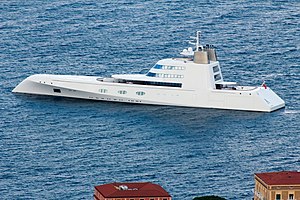Inverted bow


In ship design, an inverted bow (occasionally also referred to as reverse bow) is a ship's or large boat's bow whose farthest forward point is not at the top. The result may somewhat resemble a submarine's bow. Inverted bows maximize the length of waterline and hence the hull speed, and often have better hydrodynamic drag than ordinary bows. On the other hand, they have very little reserve buoyancy and tend to dive under waves instead of piercing or going over them.
Inverted bows were popular on battleships and large cruisers in the early 20th century. They fell out of favour, as they were very wet at high speeds and in heavy seas, but have made a comeback on modern ship design.
Examples
[edit]Motor Yacht "A"
[edit]The 390 ft luxury motor yacht M/Y "A" has an inverted bow, along with a tumblehome hull design.

Ulstein X-Bow
[edit]The Ulstein X-Bow (or just X-BOW) is an inverted ship's bow designed by Ulstein Group to improve handling in rough seas, and to lower fuel consumption by causing less hydrodynamic drag.[1] It is shaped somewhat like a submarine's bow.[2]



The MV Bourbon Orca, design AX104, is an Ulstein A-Series anchor handling tug supply vessel (AHTS) built for Bourbon Offshore Norway, the Norwegian division of the French Groupe Bourbon,[3] and was the first ship built with the Ulstein X-bow in 2006. She was awarded Ship of the Year 2006, both by Skipsrevyen[4] and Offshore Support Journal. In 2007, the Bourbon Orca design model was included in the London Science Museum's display of innovative technology. The vessel's operator claims that the design achieves higher speed and a calmer motion in head, rough seas.[5] Originally developed for offshore oil and gas vessels, the design has entered new segments such as yachts, cruise vessels, offshore wind and fisheries. In 2017, a US cruise company ordered the first four X-BOW cruise ships for arctic ice conditions,[6] and Lindblad Expeditions also ordered two such expedition cruise vessels.[7]
The number of X-BOW vessels contracted and or delivered reached the 100 mark in 2017.[8] Later developments from the X-BOW are the X-STERN [9] and TWIN X-STERN [10] hull line designs.
Zumwalt-class destroyer
[edit]The bow of the Zumwalt-class stealth guided missile destroyer for the United States Navy is also inverted. It has a wave-piercing tumblehome hull form whose sides slope inward above the waterline.[11]
See also
[edit]- Axe bow – Wave-piercing type of a ship's bow
- Bulbous bow – Protruding bulb at the front of a ship
- Naval ram – Naval melee weapon
References
[edit]- ^ Five (TV channel) television program Megastructures, 12.45 to 1.45 pm Friday 29 January 2010
- ^ "X-Bow: Innovating an old industry — The Hand & Eye". www.thehandandeye.com. Archived from the original on 2015-09-26.
- ^ Ship Of The Year 2006. Archived 2015-01-28 at the Wayback Machine Accessed: 24 January 2015.
- ^ http://ulstein.com/news/2006/2006-ahts-bourbon-orca-ship-of-the-year Archived 2021-05-14 at the Wayback Machine 2006: AHTS Bourbon Orca - Ship of the Year
- ^ A series of four Ulstein designed inverted bow PSV vessels page 16-17 Bourbon (company), 24 June 2010. Accessed: 11 March 2011.
- ^ "SunStone, China group to build 4+6 expedition cruise ships in Shanghai". 17 March 2017.
- ^ "It's official: Lindblad inks 1 + 2 newbuild deal with Ulstein". 7 November 2017.
- ^ "X-BOW cracks the 100 vessels mark". www.offshorewindindustry.com/ 16 January 2016. Accessed: 7 July 2022.
- ^ "X-Stern®". 16 March 2020.
- ^ "Two sterns provide fuel savings and maximum manoeuvrability". Archived from the original on 2022-06-28. Retrieved 2022-07-07.
- ^ "Full Page Reload". IEEE Spectrum: Technology, Engineering, and Science News. 31 July 2013. Retrieved 2020-11-10.
External links
[edit]- X-BOW
- Ulstein Group
- Ulstein Group History book Archived 2016-11-03 at the Wayback Machine
- pdf 'Bourbon Orca'
